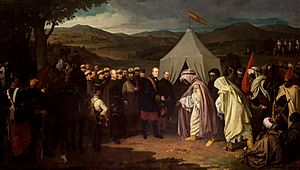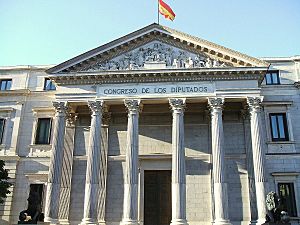Treaty of Wad Ras facts for kids

The Treaty of Wad Ras as portrayed by Joaquín Domínguez Bécquer
|
|
| Signed | April 26, 1860 |
|---|---|
| Location | Wadi Ras, Morocco |
| Signatories | |
| Parties | |
| Languages | Arabic Spanish |
|
Part of a series on the
|
|---|
| History of Morocco |
 |
|
|
Classical to Late Antiquity
(8th century BC – 7th century AD) |
|
|
|
|
|
|
Related topics
|
The Treaty of Wad Ras was an important agreement signed between Morocco and Spain. It marked the end of the War of Tetuan on April 26, 1860. The treaty was signed in a place called Wad Ras, located between the cities of Tetuan and Tangier. This agreement was very tough for Morocco. It made Morocco give up a lot to Spain, including a huge payment and more land around Spanish cities in North Africa.
The War of Tetuan: A Quick Look
Before the Treaty of Wad Ras, Morocco and Spain fought a war from 1859 to 1860. This war is known as the War of Tetuan. Morocco had faced challenges before, like a big defeat by the French in 1844. Also, in 1856, Morocco signed a treaty with Britain. This treaty opened up Morocco to more foreign trade. It also gave British people in Morocco certain rights. This reduced the Moroccan government's control over its own economy.
The war with Spain started because of small fights. Local tribes living near Spanish areas in Morocco, like Ceuta and Melilla, had skirmishes with Spanish forces. Spain saw this as a reason to go to war.
How the War Ended
Spain won a major battle at Tetuan in 1860 and took control of the city. The Spanish general, Leopoldo O'Donnell, then planned to attack Tangier. The Moroccan army, led by al-Abass Bin Abderrahman, who was the brother of Sultan Muhammad IV, tried to stop this attack at Wad Ras. However, the Moroccan army suffered a huge defeat there. This loss forced Sultan Muhammad IV to sign a peace treaty. The treaty included many difficult terms for Morocco.
What the Treaty Said
The Treaty of Wad Ras had several important points that greatly affected Morocco:
- Paying for the War: Morocco had to pay Spain a large amount of money, 20 million duros, as a payment for the war. This was a huge sum, much more than Morocco's government had. (Article 9)
- Spanish Occupation: Spain would continue to occupy Tetuan and the areas around it. They would stay there until Morocco paid the full amount of money. (Article 9)
- Expanding Spanish Land: The land around the Spanish city of Ceuta was made larger. It now stretched to the Bullones Mountains and the Anghera Rivine. (Article 3)
- Border Mapping: A group of engineers from both Spain and Morocco had to work together. Their job was to draw a very exact map of the new border lines. (Article 4)
- More Border Changes: An earlier agreement from August 24, 1859, was confirmed. This agreement expanded the borders around other Spanish areas like Melilla, Peñón de Vélez de la Gomera, and Alhucemas Islands. The new border was set at the distance of a cannon shot. (Article 5)
- Protecting Spanish Areas: The Sultan of Morocco had to provide security forces. These forces, led by a Moroccan general or officer, had to protect the Spanish areas from any hostile tribes. (Article 6)
- Giving Up Sidi Ifni: Morocco had to give up a large area of land in the south. This land surrounded an old fort called Santa Cruz de la Mar Pequeña, which is now known as Sidi Ifni. (Article 8)
- Trade Benefits for Spain: Spain and its colonies in North Africa (called Plazas de soberanía) received "most favored nation" status for trade with Morocco. This meant Spain got the best trading conditions. (Article 13)
- Lumber Rights: Spanish colonies in North Africa were allowed to freely buy and export wood. This wood could be harvested from the forests nearby. (Article 15)
- Freeing Prisoners: Both sides agreed to free any prisoners of war they had taken. (Article 16)
See also
 In Spanish: Tratado de Wad-Ras para niños
In Spanish: Tratado de Wad-Ras para niños


